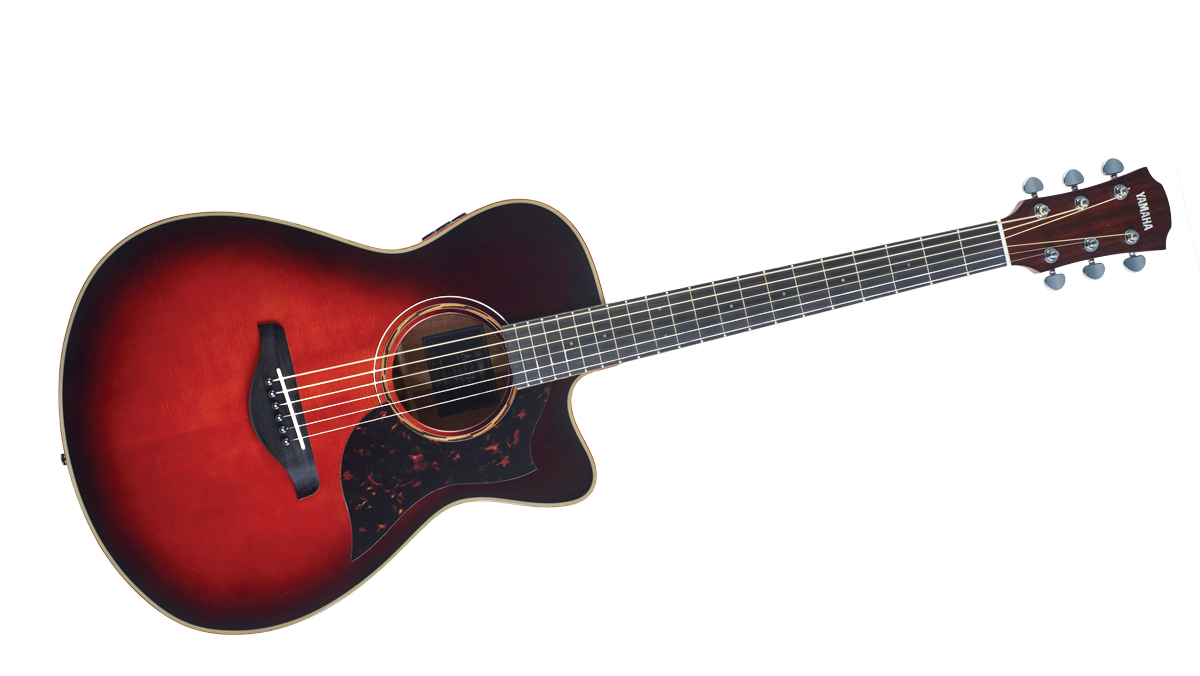MusicRadar Verdict
Yamaha is still on its ‘A game’ here.
Pros
- +
Characterful mids.
- +
One of the best pickup systems around is now more intuitive for players.
Cons
- -
Fretwork issues with our test model.
- -
A lot of competition as a dreadnought-style at this price.
MusicRadar's got your back
Any acoustic player wanting to play on stage will know it can lead to a fundamental compromise.
There is traditionally a gap between how we enjoy the sound of our guitars and the way they’re represented plugged in. Piezos, transducers and magnetic soundhole pickups are all avenues players can take, based on their tastes and needs, but none can represent the character and tonal detail of their guitars like a large diaphragm condenser mic.
It’s the recordist’s choice, but one that presents too many obstacles of feedback and positioning in live performance to be practical. Even piezo/mic blend systems can fall victim to the issue. So where now in the search for improved acoustic tone?
Enter Yamaha, a leader in stage-ready acoustic technology for decades - and in an update to its A Series, it may have just offered us a very desirable solution.
In the upper mids and trebles, there’s a darker decay in the resonance than expected
This is a series with a clear aim: “natural amplified tone”. So the A3R is built for stage use, but the considerations to general playing enhancement made here go further than the new SRT2 (Studio Response Technology) pickup system. We’ll get to that in due course.
The top has been treated with Yamaha’s ARE (Acoustic Resonance Enhancement), its take on torrefaction, to offer more vintage-voiced warmth. The build feels reassuring in weight for road use, and the mahogany binding adds a premium quality.
The Chinese-made A3R is additionally available in the Japanese model’s natural finish, too, but its dark Tobacco Brown Sunburst is an appealing alternative. Where our test A3R disappoints is with fretwork that needs further polishing in numerous places, causing unwelcome friction for bends. It’s a surprise to find and a flaw we hope is isolated.
Want all the hottest music and gear news, reviews, deals, features and more, direct to your inbox? Sign up here.
Feel & Sounds
Even with this affordable model’s high action and rosewood ’board, the rounded fretboard edges offer an enjoyable playing experience that mimics the feeling of guitars that have been played in to a degree.
In the upper mids and trebles, there’s a darker decay in the resonance than expected that’s akin to a phased effect, and it adds real character to chordwork, especially with open strings. It’s dynamically interesting to switch emphasis in strumming between the low-end and this upper-range sound. But we need to put the spotlight on the plugged-in experience, because it emerges as the primary selling point for these guitars.
The SRT2 isn’t a new concept for Yamaha. Like the original SRT launched in 2011, it’s the company’s take on a mic blend system with a piezo, except the second tone source isn’t a physical mic - it’s a digitally processed signal with two mic models on offer. Type one is a Neumann U67 large diaphragm condenser and type two offers a Royer R-122 active ribbon mic.
An electro experience that captures the sound of an unplugged acoustic? The SRT2 is one of the closest to get there yet
Yamaha has streamlined the SRT preamp options and controls: four knobs on the upper shoulder with one choosing the balance between piezo and mic simulation; pushing it in chooses between the models. So the mics aren’t real, but we do encounter some low-end feedback when plugging in the A3R that puts the onboard Auto Feedback Reduction (AFR) control to the test.
It’s also activated by a push-in control (on the bass) and applies a -12dB notch filter that deals with the issue immediately. This revised system encourages tweaking and makes it fast and intuitive.
You’ll soon find each guitar has sweet spots for you depending on the application. The condenser model proves best for chordwork with more headroom for hard strumming, while the ribbon offers lower-end presence that gives fingerstyle more girth.
Does it sound like the real thing? There’s the natural feel of lower-end presence with air and detail here that doesn’t sound artificially processed. Crucially, dialling in the mic captures the character traits of this guitar.
An electro experience that captures the sound of an unplugged acoustic? The SRT2 is one of the closest to get there yet, an update that marks the A Series out as an essential consideration for players who rely on a consistent and controllable stage sound.
This won’t be an avenue for percussive players, but for the rest of us, just add some reverb and compression on tap and new horizons await.
This improved system update underlines that acoustic tone should be about more than just the practicalities of live performance; if you feel good about your sound because you sound better, you play better.
And in terms of aiding that and upholding its reputation as a leader in the electro side of the acoustic market, Yamaha is still on its ‘A game’ here.

Rob is the Reviews Editor for GuitarWorld.com and MusicRadar guitars, so spends most of his waking hours (and beyond) thinking about and trying the latest gear while making sure our reviews team is giving you thorough and honest tests of it. He's worked for guitar mags and sites as a writer and editor for nearly 20 years but still winces at the thought of restringing anything with a Floyd Rose.
